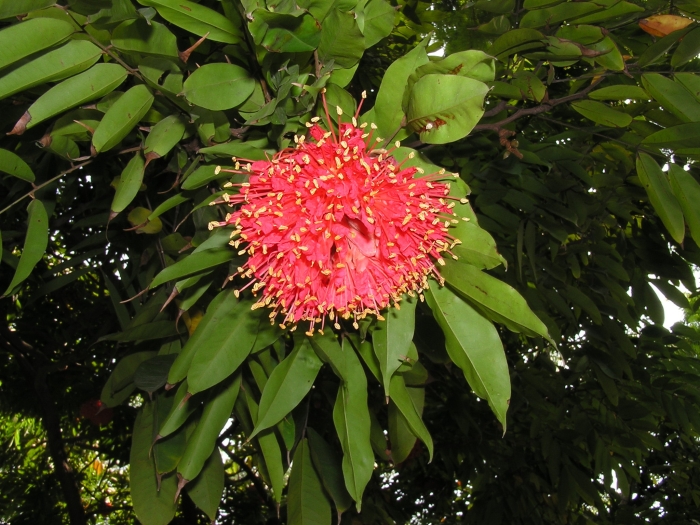Rose Of Venezuela
(Brownea grandiceps)
Rose Of Venezuela (Brownea grandiceps)
/
/

© Nasser Halaweh
CC BY 4.0
Image By:
© Nasser Halaweh
Recorded By:
Copyright:
CC BY 4.0
Copyright Notice:
Photo by: © Nasser Halaweh | License Type: CC BY 4.0 | License URL: http://creativecommons.org/licenses/by/4.0/ | Uploader: nasserhalaweh | Publisher: iNaturalist |























Estimated Native Range
Summary
Brownea grandiceps, commonly known as the Rose of Venezuela or Scarlet Flame Bean, is a small, slow-growing evergreen tree native to the understory of tropical rainforests in Brazil, Ecuador, Venezuela, Peru, and Colombia. It typically reaches about 20 feet in height and is noted for its stout branches and greyish-brown bark. The leaves are opposite and pinnate, providing a lush, green backdrop for the spectacular flowers. The plant is renowned for its large, globular inflorescences that burst with numerous crimson, red, deep pink, or purple tubular flowers, each with projecting stamens and styles, during the flowering season which peaks in the spring and summer months. These showy blooms are highly attractive to hummingbirds and butterflies, making it a valuable plant for supporting local wildlife.
The Rose of Venezuela is celebrated for its ornamental flowers and is often used in tropical gardens, conservatories, and as a specimen plant. It thrives in warm climates and requires a minimum temperature of 55°F to avoid cold damage. In cultivation, it prefers high humidity, consistent moisture, and well-draining, fertile soil. It is best situated in partial shade to mimic its natural understory habitat. While it is not commonly afflicted by pests or diseases, root rot can occur in poorly draining soils. Due to its slow growth rate and sensitivity to cold, it is less commonly grown in temperate regions but can be successful in the right microclimate or when given winter protection.CC BY-SA 4.0
The Rose of Venezuela is celebrated for its ornamental flowers and is often used in tropical gardens, conservatories, and as a specimen plant. It thrives in warm climates and requires a minimum temperature of 55°F to avoid cold damage. In cultivation, it prefers high humidity, consistent moisture, and well-draining, fertile soil. It is best situated in partial shade to mimic its natural understory habitat. While it is not commonly afflicted by pests or diseases, root rot can occur in poorly draining soils. Due to its slow growth rate and sensitivity to cold, it is less commonly grown in temperate regions but can be successful in the right microclimate or when given winter protection.CC BY-SA 4.0
Plant Description
- Plant Type: Tree
- Height: 15-20 feet
- Width: 15-20 feet
- Growth Rate: Slow
- Flower Color: Red
- Flowering Season: Spring, Summer
- Leaf Retention: Evergreen
Growth Requirements
- Sun: Full Sun, Part Shade
- Water: Medium
- Drainage: Medium, Slow
Common Uses
Bird Garden, Butterfly Garden, Low Maintenance, Potted Plant, Showy Flowers
Natural Habitat
Understory of tropical rainforests in Brazil, Ecuador, Venezuela, Peru, and Colombia
Other Names
Common Names: Scarlet Flame Bean
Scientific Names: , Brownea grandiceps, Brownea amplibracteata, Brownea araguensis, Brownea ariza, Brownea holtonii, Brownea loretensis, Brownea neglecta, Brownea princeps, Hermesias grandiceps
GBIF Accepted Name: